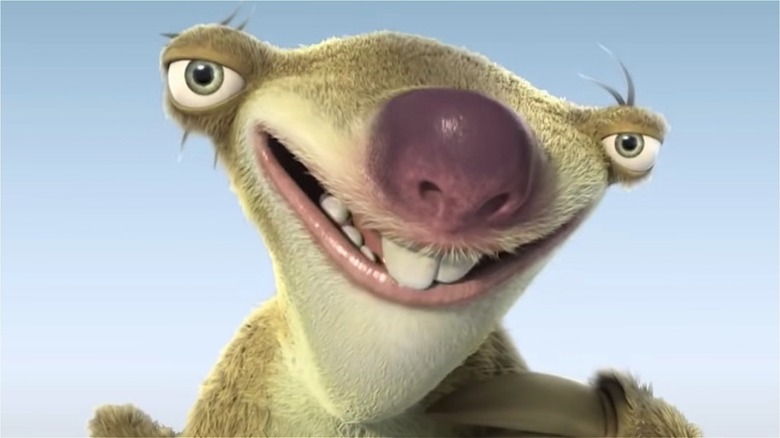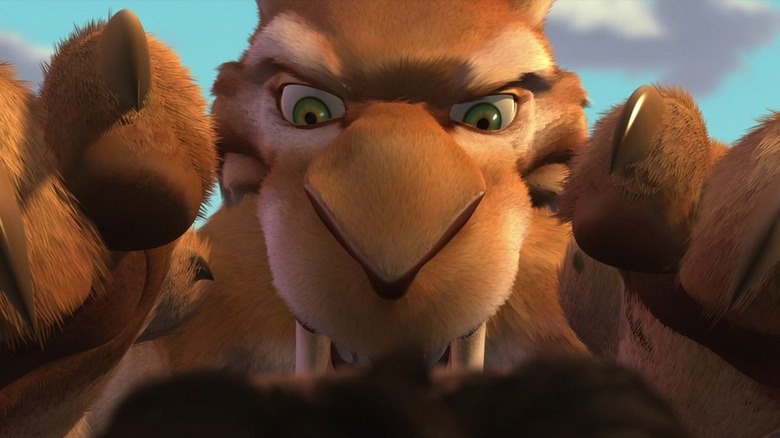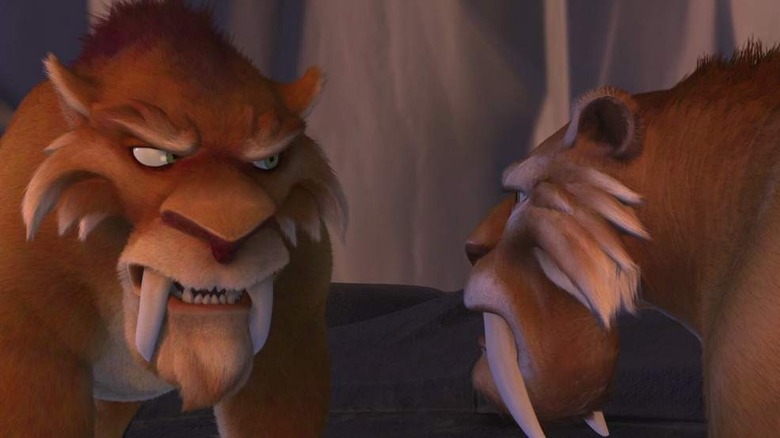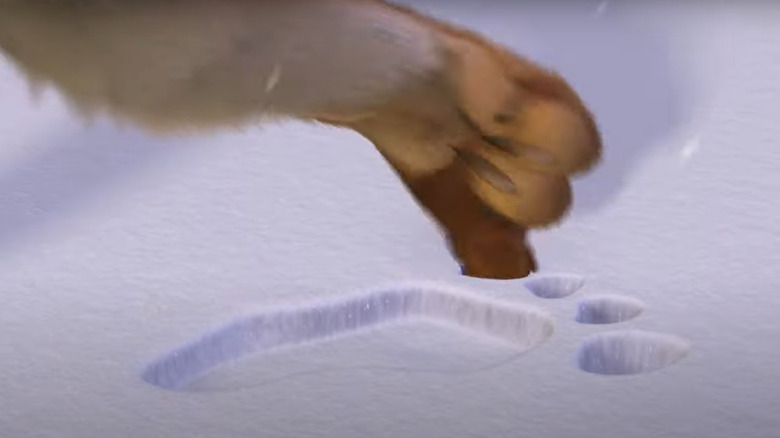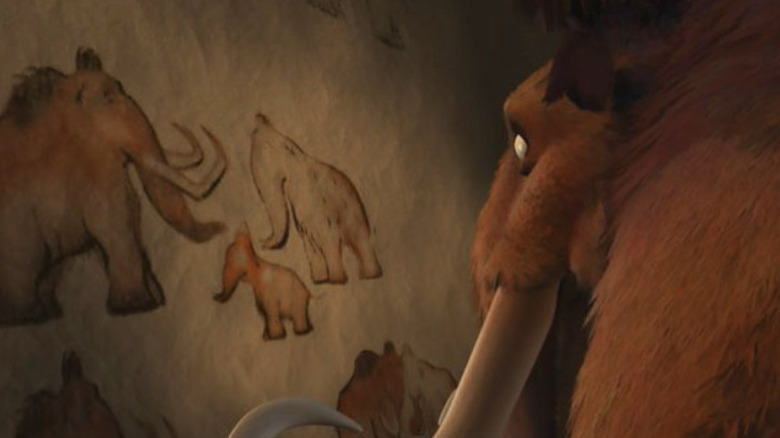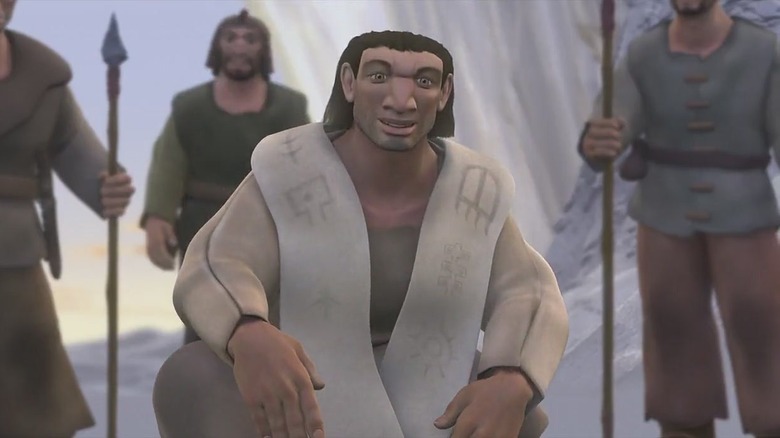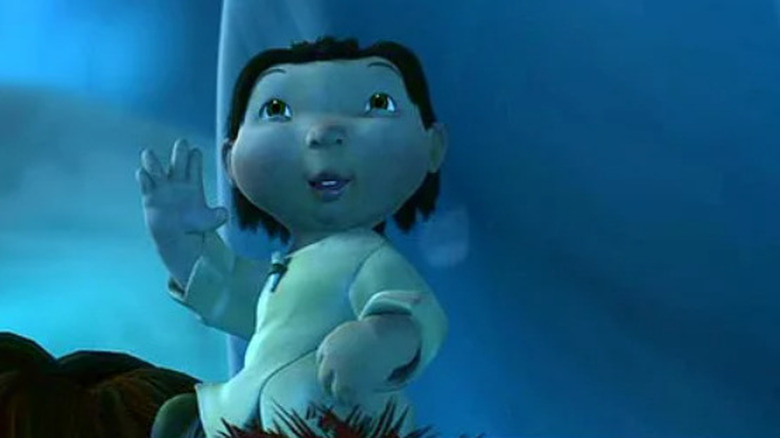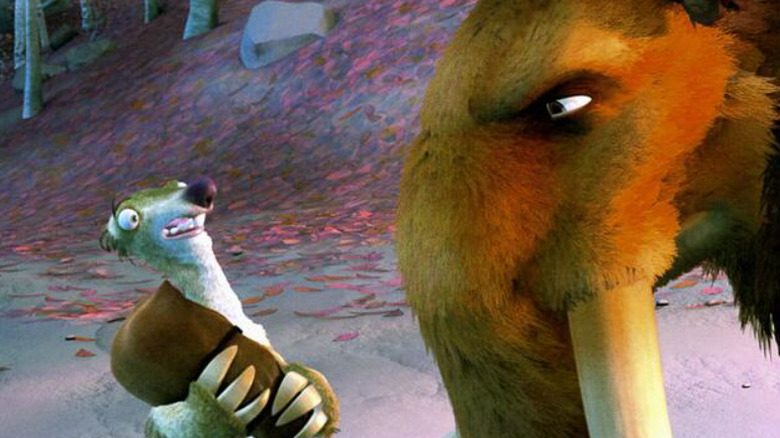Things Only Adults Notice In Ice Age
The early 2000s were an exciting time for CGI animation. The success of movies like 1995's "Toy Story" and 2001's "Shrek" proved that 3D cartoons could make for just as impactful storytelling as traditional hand-drawn 2D animation. One other film that majorly helped kickstart the CGI movies trend was 2002's "Ice Age."
The movie tells the story of a group of pre-historic animals living during the ice age. Manny the mammoth, Sid the sloth, and Diego the saber-tooth tiger become unlikely allies on a quest to help a human toddler get back to its tribe. Along the way, the animal trio have to contend with a number of challenges ranging from the cold and unforgiving environment to predators looking to turn the toddler into a snack.
"Ice Age" was praised for its combination of humor and a genuinely poignant central story about moving on from loss and finding strength in new companions. The success of the movie spawned one of the most prominent animation franchises of the 2000s, although most fans agree the first "Ice Age" remains the best entry in the series so far. Here are some things about the movie that you notice as an adult which might have gone over your head as a kid.
Carnivores are friends with their prey
The problem with telling stories about animals that behave like humans is that at some point the mixing up of animal rules and human rules lead to some uncomfortable speculations. Take for instance the friendship between Diego, a predatory tiger, and Manny and Sid, two animals that the tiger would ordinarily feast on.
A big part of "Ice Age" is Diego learning to stop seeing Manny and Sid as prey, and start seeing them as his friends instead. In the end, Diego decides to become friends with the other two rather than trying to eat them. But you have to remember that Diego is still a carnivorous predator, which means sooner or later he is going to eat a fellow animal to survive.
And now we know that Diego's next prey will also be a talking, feeling animal just like Sid and Manny. Later movies even show the animals of that world, carnivores and herbivores alike living together in a close-knit society. That means every time a predator eats a fellow animal in this world, they are eating someone they knew, spoke to, and were maybe even friendly with. In human terms, that's called a cannibalistic society.
Soto saw Diego as a threat
Soto was the leader of the pack of saber-toothed tigers that Diego was a part of. It was Soto who ordered Diego to infiltrate Sid and Manny's group so the tigers would be able to take down the mammoth unawares and capture the baby. Although Soto declared Diego a part of his pack, his actions told a different story.
Right from the start, Soto is clearly acting passive-aggressively towards Diego. He is harsh with his criticisms, and bluntly tells Diego that any further mistakes would lead to the most extreme punishment for him. In the end, it is Soto who personally prepares to kill Diego for the sin of betraying their pack. Soto's actions make a lot more sense when you consider that he is clearly older than the other tigers.
In the wild, growing older means your position will inevitably be filled by someone younger and stronger. In Soto's pack, that someone was Diego. Even though he was Soto's second-in-command before, the time was not far off when Diego would be challenging Soto for the role of leader of the pack. Perhaps Soto saw Diego's failures with the human baby as a handy excuse to get rid of his rival before he became a threat.
Diego made a pretty convincing human footprint
In one scene, Diego tries to hide the fact that his fellow tigers were following Manny and Sid by turning a tiger paw print into a human footprint. But Diego's attempts at the deception are quite laughable. He makes the print look like the foot of an animal, with only four toes and no footwear.
While Diego's human footprint would not have fooled actual humans, you have to remember that it was a couple of animals that the footprint was supposed to fool. Diego drew a bare human foot because animals have not figured out the concept of human clothing, or the fact that humans wear things on their feet to protect their bodies from the ground.
Similarly, Diego only drew four toes on the print because all the characters in the movie have four digits on their limbs. The human footprint was authentic enough to fool even Manny, who is shown to be a reasonably intelligent animal, so clearly Diego knew what he was doing.
The all too real cave painting
Despite being a children's movie, "Ice Age" was not afraid to go super dark with its characters. One of the saddest scenes in animation history is when we get to see Manny's backstory, told through a series of crude cave paintings that he and the others encounter. Even though the paintings are as basic as you can get in terms of animation, they pack an emotional wallop, and include a lot of details that children might not pick up on.
We see Manny living a life of peace and happiness with his wife and children. Then we see the family being attacked by a pack of human hunters. The humans work with a great deal of cunning, and it is anything but a random attack. First Manny is pinned off to the side by a crowd of hunters since he is the biggest threat. This allows for Manny's wife and kid to become easier targets.
Since a female mammoth's tusks are smaller, and not as good at offensive strikes, Manny's wife has no option but to attempt to shield her child from the hunters. We also notice that some of the hunters are attacking from a clifftop. That is because the necks of mammoths are not flexible enough to look up to spot danger. This kind of brutal hunting efficiency and planning is what allowed the human hunters to take down Manny's family while all he could do was watch helplessly.
The human characters are from an extinct species
It is a generally accepted maxim that cartoons work best when you have human characters to sympathize with, or animals that dress and act like humans. "Ice Age" does something clever with its human characters in keeping with its theme of exploring a world filled with prehistoric creatures that do not exist today.
The human characters in the film are not homo sapiens, but rather Neanderthals. What's the difference between the two? While both fall under the category of the human species, they are quite distantly related in real life, meaning they shared a common ancestor roughly half a million years ago. The Neanderthals were also mostly hunters and gatherers at a time when homo sapiens had already taken to farming and staying in one location.
In "Ice Age," the broad, flat features of baby Roshan and his family make it clear that they are Neanderthals who eventually went extinct rather than ancestors of modern homo sapiens. Roshan and the other humans are also never shown speaking, in keeping with scientific speculation that the Neanderthals never developed a language. That means the "Ice Age" series never featured any "modern man" characters, until the Christmas special "Ice Age: A Mammoth Christmas," which featured a visit from Santa Claus.
The Vulcan salute
If there is one thing storytellers love to do, it is to pepper in their works with references to stories that they are fans of. Something similar happens in "Ice Age" when the three main animals plus their tiny human enter a frozen ice cave filled with relics of creatures and things from distant lands.
One of the things the group encounters is what appears to be a UFO that got stuck in a wall of ice. Upon seeing the extraterrestrial object, the human child raises its hand to it in salute with the fingers parted between the middle and ring finger. This, of course, is the famous "Vulcan salute" made popular by Spock (Leonard Nimoy) from the "Star Trek" television series.
Interestingly, aside from referencing "Star Trek," the ice cave sequence also references a number of creatures that showed up in later "Ice Age" movies. The frozen piranha makes an appearance in "Ice Age: The Meltdown." The frozen dinosaur is a part of "Ice Age: Dawn of the Dinosaurs." The frozen sloths that Sid encounters are like his biological family that show up in "Ice Age: Continental Drift," and finally, the UFO has a part to play in "Ice Age: Collision Course."
Sid talks with a drunken lisp
Sid the Sloth was an instant fan favorite right from his first scene when he angers a couple of prehistoric rhinos. While Sid is loving and helpful, he is not very cool, collected, or particularly coordinated. Even his manner of speech is slightly off, as he talks with a strange lisp and occasionally slurs his words.
For adults, this can make it almost seem like Sid talks like a drunk person sometimes. And that would be a fair assessment. Actor John Leguizamo, who voices Sid, revealed when talking about his approach to the character that he based his voice for Sid on real sloths, who often store food in their mouths and which can sometimes turn into alcohol.
"To find out more about my character, I watched footage of sloths," Leguizamo explained in an interview with MovieWeb. "I discovered that the food they store in their pouches rots and ferments and half the time they're drunk." And so Leguizamo voiced Sid as a creature that has a habit of storing food in its mouth, resulting in the slight lisp, and who occasionally gets drunk and starts slurring his words.
